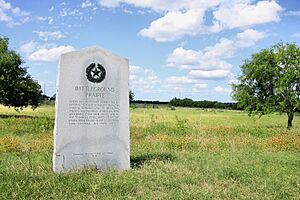Córdova Rebellion facts for kids
The Córdova Rebellion was an uprising in 1838 near Nacogdoches, Texas. It was led by Vicente Córdova, a local leader (called an Alcalde). He and others supported the Texas Revolution at first. But they wanted Texas to return to the old Mexican Constitution of 1824.
Why the Rebellion Started
Vicente Córdova began planning this secret resistance as early as 1835. He expected Texas to declare its independence from Mexico. In the summer of 1838, news spread that Mexico was talking with the Cherokee people. Mexico offered them land if they would help fight against the Texans.
The Fight at Battleground Prairie
People from Nacogdoches found a camp of about one hundred armed Tejanos (Texans of Mexican heritage). President Sam Houston was in Nacogdoches at the time. He told both sides not to gather or carry weapons.
Vicente Córdova and eighteen other leaders made a list of demands. They said they would not give up their weapons until these demands were met. About three hundred Native American warriors joined them. They then moved towards the Cherokee settlements.
Thomas J. Rusk was a representative in the Texas Congress. President Houston told him not to cross the Angelina River. But Rusk sent 150 men, led by Major Henry Augustine, to stop the rebels.
On March 29, 1839, General Edward Burleson led 80 men. They defeated Vicente Córdova and his rebels. This fight happened near Seguin, Texas, at a place called "Battleground Prairie." Córdova was hurt but managed to escape to Mexico. He was chased by Mathew Caldwell and his rangers. Thirty-three rebels were put on trial for treason. Later, they were pardoned or set free.
What Happened Next?
A few weeks later, a Mexican agent was killed near the Red River. A diary and papers were found on him. These papers showed that Mexico was trying to get the Cherokee and other tribes to rebel against Texas. Mexico promised to recognize their tribal lands.
More documents were found after two battles in May 1839. One was on the North San Gabriel River. The other was after Texas Rangers defeated a group of Mexicans and Cherokee. These papers included letters from Mexican officials to Córdova and Chief Bowl, a Cherokee leader.
President Houston believed Chief Bowl's claims that he was not involved. Houston refused to arrest the Cherokee. He wrote several letters to Chief Bowl during this time. Houston again promised the Cherokee title to their land on the Neches River.
However, some warriors believed their lands were being taken by new settlers. In October 1838, they attacked and killed eighteen people. This event was called the Killough massacre.
Texas' second president was Mirabeau B. Lamar. He had seen how Native American lands were taken in Georgia. Lamar was not friendly towards Native Americans. After the Killough incident, Lamar demanded that the Cherokee leave Texas. This led to the Cherokee War in 1839. The Cherokee were forced to leave Texas. This event is often called the "Cherokee removal" to Indian Territory.
Córdova returned to Texas in 1842 with General Adrián Woll's invasion. He was killed on September 18, 1842, in the Battle of Salado Creek.


